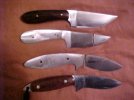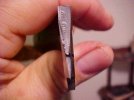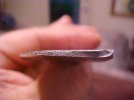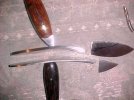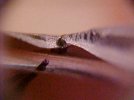- Joined
- Jul 9, 1999
- Messages
- 3,316
I needed to know what's going on with the HT with this 1084 I'm using. I single edge quenched one blade and triple tempered it. No normalizing. It's 1/8" stock. I then broke one of my banana knives(3/16" stock) which was triple normalized, triple edge quenched and triple tempered.
Here are some pics of the results. Your observations and comments are very welcome as I'd like to know the board's consensus of what's showing in the pics. I'll have to post one, then follow with a thread with another pic and so on 'cuz that's the only way I know how to do it.
Pic one is the three x three. It broke near the plunge line after it nearly broke me trying to break it. I ended up having to use a pair of 12" Channel-lock pliers to give me the leverage to break it. BTW, I'm 275 lbs. and still ended up falling flat on my butt when it finally gave up the ghost.
edited to add:
Actually, the first pic is of the two blades that I sacrificed with a finished sample of the same model on top and bottom. The only difference is the 1/8" stock model's finished sample is in 3/16" stock and was treated 3x3.
Thanks for looking and responding!
Here are some pics of the results. Your observations and comments are very welcome as I'd like to know the board's consensus of what's showing in the pics. I'll have to post one, then follow with a thread with another pic and so on 'cuz that's the only way I know how to do it.
Pic one is the three x three. It broke near the plunge line after it nearly broke me trying to break it. I ended up having to use a pair of 12" Channel-lock pliers to give me the leverage to break it. BTW, I'm 275 lbs. and still ended up falling flat on my butt when it finally gave up the ghost.
edited to add:
Actually, the first pic is of the two blades that I sacrificed with a finished sample of the same model on top and bottom. The only difference is the 1/8" stock model's finished sample is in 3/16" stock and was treated 3x3.
Thanks for looking and responding!

